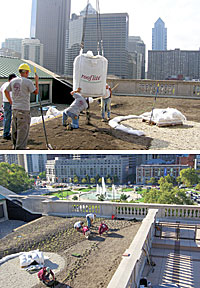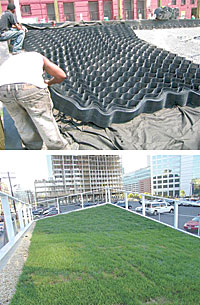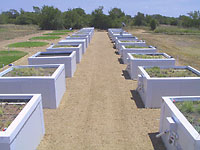 BioCycle May 2009, Vol. 50, No. 5, p. 17
BioCycle May 2009, Vol. 50, No. 5, p. 17
Compost takes foothold in green roof growing media, providing a profitable and expanding market for the organics recycling industry.
Rhodes Yepsen
THE driving force behind the current popularity of green roofs is their measurable environmental benefits. This is good news for composters, because green roof growing media increasingly includes compost.
The U.S. Green Building Council awards LEED points for green roofs under several categories, including storm water management, reducing heat island effect, water efficient landscaping, optimizing energy performance, recycled content, regional materials and innovative design process.
Green Roofs For Healthy Cities (GRHC), North America’s green roof industry association, is developing new standards for green roof media. “There’s a long-standing debate about how much organics to include in green roof media,” says Rick Buist, Chair of the GRHC Growing Medium committee, and President of Bioroof Systems. “To focus this discussion, our growing media standards will be based on performance characteristics, such as water holding capability, porosity, drainage, weight and biological/chemical characteristics.”
These performance-based standards are a divergence from the FLL guidelines, which were developed by the German
ResearchSociety for Landscape Development and Landscape Design. The FLL Guidelines are prescriptive, says Buist, specifying allowable materials and percentages. “By defining green roof media according to performance, we’ll be able to assure performance in the marketplace,” he explains. “If green roofs are sold on the expectation of benefits such as storm water retention and cooling effects, then we need to make sure green roof media perform their role. The FLL is too loose of
a standard, allowing for growing media that, for example, don’t properly retain moisture.”
Basing the new GRHC standards strictly on performance will hopefully remove industry biases toward use of compost and aggregates, adds Buist. This will benefit the composting industry by not specifying a maximum amount permitted, and will impact the aggregate industry by allowing a wider range of product manufacturers (right now there is one dominant lightweight aggregate company). “We plan on eliminating confusion about what percentages are required,” says Buist. “Our standards will set performance parameters, but won’t dictate how much or what type of organic and aggregate can be used. It will also open the industry to new and innovative products that may meet the performance requirements but not necessarily be considered suitable under the German-based FLL standards. At the end of the day, this will be a much more useable and robust standard.” To date, the committee has defined which performance characteristics should be included.
Predeveloped Hydrology
Storm water management is often cited as one of the biggest advantages of green roofs, drastically reducing the amount of runoff during rain events. “After a few years of severe drought, Georgia received a lot of rain this year, but due to impervious surfaces in cities, much of that water was not retained, causing runoff into streams and flooding events,” says Scott King of ERTH Products, a Georgia composting company that specializes in manufacturing and engineering specialty soils. “We work with architects and engineers to try and mimic the predeveloped hydrology of a site, using functional soils and systems to retain water on site. Instead of focusing on just a green roof or bioretention pond, we look at the whole system.”

ERTH Products composts biosolids and peanut hulls using aerated static piles (ASP), which it mixes with aggregates for green roof media blends. “From a volume standpoint, green roof media doesn’t require a lot of compost, compared to bioremediation and other projects,” notes King. “However, green roof media has a higher profit margin, because of the degree of testing required and the end market. We have our own green roof mix, and also blend to green roof contractors’ specs, such as for modular grid systems.”
In Atlanta, over 70 percent of green roofs are intensive (soil depth greater than 6 inches), says King. Although these tend to be more costly than extensive roofs (soil depth less than 4 inches; see sidebar), there are several factors at play. “Intensive green roofs have a public use,” he explains. “There has been a condo building boom in Atlanta during the past 5 to 10 years, and they can combine an intensive green roof with a pool deck, plaza or courtyard, a space that is utilized by residents and guests. Extensive roofs retain water on site and reduce the urban heat island effect, but the public rarely sees them, making them more common on institutional buildings in the region.”
There are several methods for installing green roof media, including conveyors, cranes lifting large “super sacks,” pallets of smaller bags on a freight elevator and pneumatic blower trucks. “The method of delivering engineered soils to the rooftop definitely depends on the building,” says King. “We sometimes still load pallets of 30-lb bags on a freight elevator, and will use 1-cubic yard super sacks, but blower trucks are more cost-effective. We’ve gone as high as 10 floors with a blower truck, but you’re limited with how high you can go, losing production as you go up.”

Several companies manufacture blower trucks, including Peterson Pacific Corp. Peterson offers two sizes of pneumatic blower trucks, with 40 and 60 cubic yard capacity, as well as a blower trailer. When using blower trucks on a large job, ERTH Products delivers the green roof media to a tipping area near the blower truck, so that a loader can continuously fill the truck. The truck hose can be snaked through the building, or it can be attached to the exterior wall. With this latter method, a tough pipe made of PVC or enforced with wire mesh is sometimes fastened to the side of the building to prevent aggregates from puncturing the hose at high elevations. A flexible hose is then used on the rooftop.

Marketing A Blend
Laurel Valley Soils (LVS) composts mushroom substrate, and mixes customized soils. “In 2004, after blending a green roof medium for several years, LVS formed a new company called Sklyand to market branded green roof media, rooflite™,” says Joe DiNorscia, Managing Director of Skyland USA, and General Manager of Laurel Valley Soils in Pennsylvania. “Prior to 2004, a large order of green roof media for LVS would’ve been for a 2,000 to 4,000 square foot roof, but then the market finally expanded, with more projects and roofs over 40,000 square feet in size. To date, we have provided green roof media for over 1 million square feet.”
Skyland has nine blending locations across the U.S., including LVS, which are licensed to produce rooflite. “The blenders use a variety of composts, and run the media through the German FLL protocol to ensure a standardized product,” says DiNorscia. “One of the differences is regionally available aggregate. Many small aggregates don’t qualify for LEED points, because they are shipped too far, or ‘expanded’ using energy intensive kilns. In the Northwest, however, naturally occurring pumice can be used as an aggregate and achieve LEED points.”
The main branch of Philadelphia’s Free Library recently installed a 5,000 square foot extensive green roof using 100 cubic yards of rooflite. “This is the first green roof on a public building in Philadelphia, and is part of Mayor Michael Nutter’s green initiatives,” says Jim Pecora, Free Library Project Manager. “The library’s roof was being renovated, providing an ideal opportunity to install the green roof, which is primarily sedum and grass, but includes a semi-intensive area with taller plants.”

Advantage of Biosolids Compost
Other composters blend green roof media almost exclusively for national green roof companies. American Hydrotech has a network of soil blenders across the country. “WeCare Organics is one of American Hydrotech’s approved green roof media blenders, and about 85 percent of our green roof media is blended to their specs,” says Brian Fleury of WeCare Organics, LLC. “We blend at three different locations, depending on the green roof installation. Our Rockland County (New York) composting facility blends for New York City and Connecticut, in order to achieve LEED points for regionally sourced material.”
Nathan Griswold, Garden Roof Coordinator for American Hydrotech, explains that the company “has various blends, based on local requirements and growing characteristics. American Hydrotech doesn’t install the green roof, but is a single source provider, from the waterproofing membrane all the way up to the plants. We offer a two-year maintenance program, and will consult throughout the life of the roof.”
Like ERTH Products, WeCare uses composted biosolids in its mixes, which have a high organic nutrient content, compared to composted yard trimmings, adds Fleury. “This high organic nutrient component is important for balancing the amount of compost used. Too much compost can lead to excessive water retention and weight issues, not to mention nutrient runoff. However, compost is needed to support the plants, making biosolids compost a great fit.”
Some high profile projects require special attention, such as the Lincoln Center in New York City. “Four years ago, a Lincoln Center mock-up was built in a parking lot in Jersey City (New Jersey),” says Fleury. “We tested the performance of the growing medium over several years and adjusted the blend accordingly, in this case adding more compost and silt fines for additional water retention. The project is now approved, with 300 cubic yards of medium scheduled for delivery this spring. Each 100 cubic yards will be tested separately, to ensure the correct blend.”

Tests On Miniature Roofs
Starting in 2006, researchers at the Lady Bird Johnson Wildflower Center (LBJWC), University of Texas at Austin, have been testing various green roof configurations in a subtropical climate. Although general comparisons of green versus conventional roofs have been addressed, and studies have been conducted on major design variables (e.g. substrate type and depth), LBJWC set up a test to examine certain variables more closely, and interactions between variables that had previously been overlooked. This includes construction of a drainage layer, monolithic (built in place) versus modular construction (preplanted containers such as plastic trays or grids), presence of a retention blanket, use of native plants and other biotic (living) effects on cooling and retention.
“To address some of these issues, the first goal of this project was to examine hydrologic, thermal and biotic responses and interactions of six different extensive green roof designs planted with identical native species, and two conventional roofs, with nonreflective black and reflective white roofs,” says Mark Simmons an Ecologist at LBJWC. The test roofs measure 5 feet by 6 feet, with a total of 24 miniature roofs in all (3 of each type). “In the preliminary findings, we suggest that as green roofs vary so much in design, they must be designed according to specific performance goals, and not on assumed performance attributes,” he continues. “These will vary among geographic location and client needs, but must be stated early in the design process to assess whether or not the green roofs are a suitable option, and if so then dictate the biotic and abiotic components of the design.” Abiotic components are nonliving features (e.g. ponds) that support biotic, or living features (e.g. plants, animals).
LBJWC’s study is now in a second stage, examining plant performance and more affordable growing media components, including more recycled materials such as compost and mulch. While extensive roofs typically rely on succulents, LBJWC is testing a wider range of plants. “Ideally, plants on green roofs should produce their own compost, with dead leaves and a natural turnover of organic material creating an equilibrium,” explains Simmons. “We are looking to identify an optimum level of organic material for extensive green roofs, and one that’s self-sustaining, because loss of organic material volume means potential contamination of runoff and loss of root volume, which can stress the plants and cause loss of functionality of the green roof.”
Green Roofs For Healthy Cities is holding its annual conference in Atlanta from June 3 to 5, 2009. Having established which performance-based characteristics to include in the new standards, the GRHC Growing Medium committee will be meeting at the conference to identify the best testing methodology to measure and support those characteristics. “With momentum building for green roofs and engineered soils, I’m glad to see that performance based specifications are being developed,” concludes King. “This will serve to benefit everybody by opening up the market to more composters and aggregate producers, and ensuring a higher success of green roof installations.”
SIDEBAR p. 18
Extensive Vs. Intensive Green Roofs
GREEN roofs are often broken into two categories based on the depth of the growing medium and what plants are supported. Extensive green roofs have a shallow depth, typically between 2 and 4 inches, and support primarily grasses and sedums. They do not require a lot of structural support, and are intended to be low maintenance and low cost. Intensive green roofs have a deeper depth of growing medium, typically over 6 inches, and can support a wider variety of plants, sometimes including full-size tress. They generally require more management and irrigation systems, as well as more structural support, and subsequently often cost more than extensive installations. A third category, semi-intensive, is sometimes used to describe the in-between range of 4 to 6 inches of growing medium.
Recent BioCycle articles on green roofs include: “Green Roofs Grow…With Brown Compost,” September 2004; “Compost Plays Key Role In Green Roof Mixes,” March 2005; “Green Roof Storm Water Modeling,” February 2006; “Compost Utilization Goes Through The Roof,” March 2006; and “Rethinking The Green Roof,” September 2006; “Storm Water Management, Green Roof Style,” May 2007.










